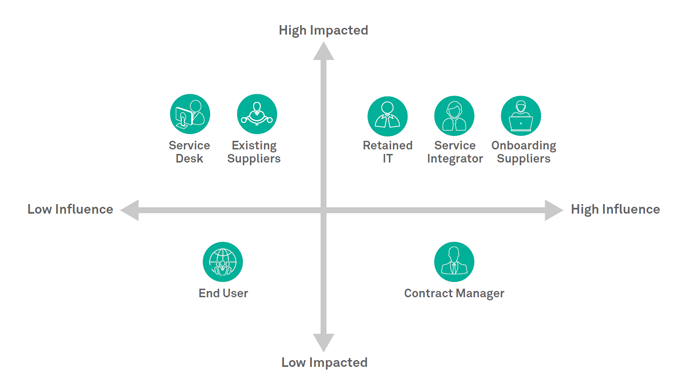1. INTRODUCTION
The increase in complexity of today’s IT environments managed by various suppliers requires a structured and robust supporting model that can be provided to customers toward delivering services in an effective and collaborative manner. The SIAM (service integration and management) capability provides valuable insights and acts as a guide in setting up a SIAM organizational structure.
Through this whitepaper, we would like to share our practical experiences of the approach taken to onboard suppliers in an SIAM ecosystem. Effective onboarding can improve collaboration between the customer, service integrator, and suppliers. It will also ensure that suppliers feel welcome and prepared, in turn giving them the confidence to deploy the right level of resources to make a positive impact within the SIAM model.
2. KEY STAKEHOLDERS
Stakeholders are those who may be impacted by or influence supplier onboarding. Identifying the right stakeholders is an important element in this approach. We suggest identifying stakeholders based on the degree of influence they would have on the entire supplier-onboarding process vis-à-vis the impact it would have.


The following outlines the pragmatic approach for onboarding suppliers:
3.1 SEQUENCING THE APPOINTMENT OF SUPPLIERS
Suppliers are broadly classified into three types:
Prioritizing the onboarding of core SIAM suppliers first, followed by non-core SIAM suppliers, and finally the commodity suppliers is the recommended approach. This sequence is based on the below matrix of ‘Business Value Contribution’ versus ‘Overall Risk on the Systems/Business’ and is helpful in minimizing the risks associated with the transition of such an activity.

In addition, here is a short list of recommendations to consider while evaluating the onboarding of suppliers:
3.2. STANDARDIZED ONBOARDING PLAN
An onboarding plan aims at making new suppliers familiar with the overall strategy formulated to onboard suppliers and get them acquainted with processes and tools. It also acts as a reference document to track the progress of the supplier’s onboarding.
The owner of this plan is the service integrator.
The details below should be captured in the plan:
3.3. SUPPLIER CONTRACTUAL PROCESSES AND TOOL ALIGNMENT
As a prerequisite, the service integrator should work with suppliers to understand their contractual processes and tools agreement with the customer.
The objective is to design an integrated process supported by tools that will ensure all suppliers are engaged properly in the service-delivery model and are able to provide value.
Before the planned supplier onboarding workshop, a draft version of the process documents and tool integration plan should be ready.
3.4. SUPPLIER ONBOARDING WORKSHOP
The objective of the workshop is to introduce new approaches and working models and resolve operational details of the implementation.
These workshops require extensive preparation. The retained customer organization, service integrator, and suppliers should all have a clear, mutual understanding of the contractual commitments. The service integrator is responsible for driving the workshop.
The below-mentioned actions should be carried out during the workshop:
3.5. FORMAL AGREEMENT BETWEEN SERVICE INTEGRATOR AND SUPPLIERS
Post conclusion of the workshop and after agreement of the onboarding plan, a formal agreement between the service integrator and the suppliers should be facilitated by the retained IT. There are various names for such agreements, including Joint Way of Working (J-WOW), Memorandum of Understanding (MOU), Information Sharing Document (ISD), etc.
The agreement should cover details on agreed processes, tools, governance, service levels, and reporting.
3.6. ONBOARDING SIGN-OFF
The service integrator should be responsible to get a sign-off from the customer and the suppliers on completion of the onboarding exercise.
The below verification should be performed at the final stage:
References
Scopism. (n.d.). www.scopism.com.
Rohan Pisal
Wipro’s Principal Consultant for ITIL & SIAM Practice
Rohan Pisal is Wipro’s Principal Consultant for ITIL & SIAM Practice. He is an ITIL 4 and SIAM Foundation certified professional. Rohan has 17 years of experience in IT infrastructure support, SAM/ITSM/ITIL/ISO 20k process implementation and sustenance, and process governance.
Ronald Coutinho
Wipro’s Principal Consultant for ITIL & SIAM Practice
Ronald Coutinho is Wipro’s Principal Consultant for ITIL & SIAM Practice. He is an ITIL 4 Managing Professional, V3 Expert, and SIAM Foundation certified professional. Ronald has 16 years of experience in IT Infrastructure support, Quality Management, ITSM/ITIL/ISO 20K process implementation and Sustenance, and process governance.
Rohan Kadam
Principal Consultant for the ITIL & SIAM Practice
Rohan Kadam is a Principal Consultant for the ITIL & SIAM Practice in addition to being an ITIL 4 Foundation, SIAM Architect, ITIL 2011 Expert, and Six Sigma Green Belt. Rohan has 17 years of experience in IT infrastructure support, Consultancy, Audits, Training and Process improvements in areas related to Service Integration & Management (SIAM), IT Service Management, Information Security, Risk Management, Governance & Business Continuity.
Click here to download your copy of State of IT infrastructure report 2020